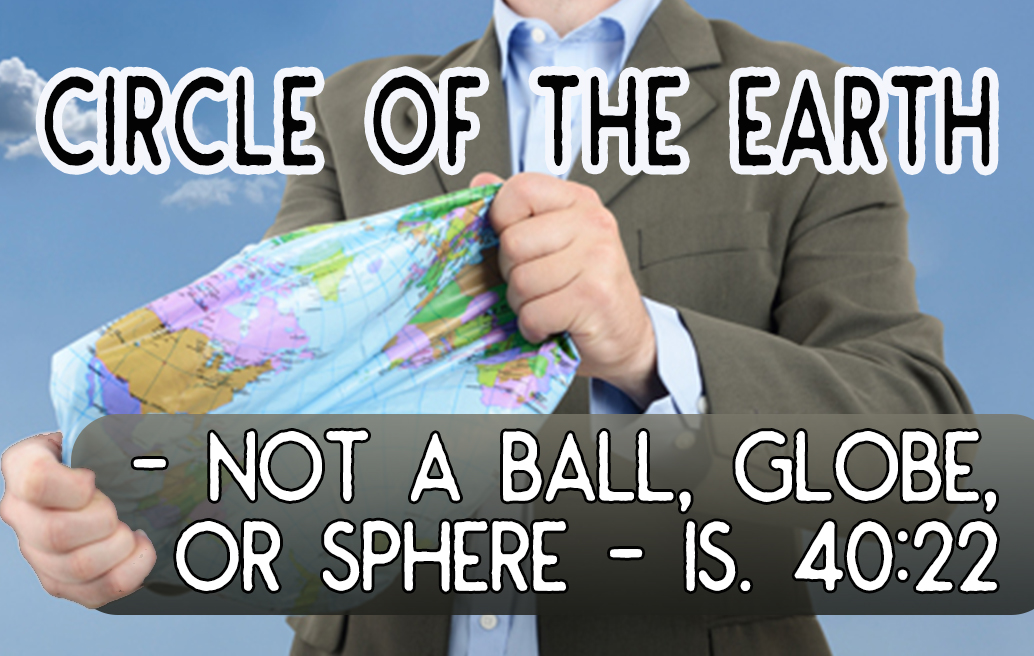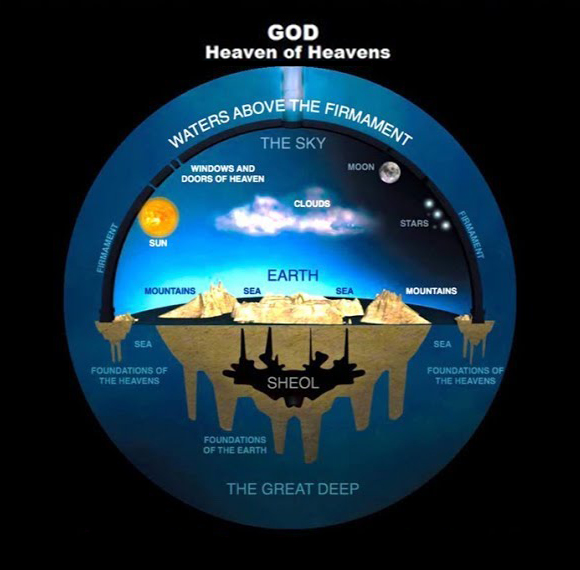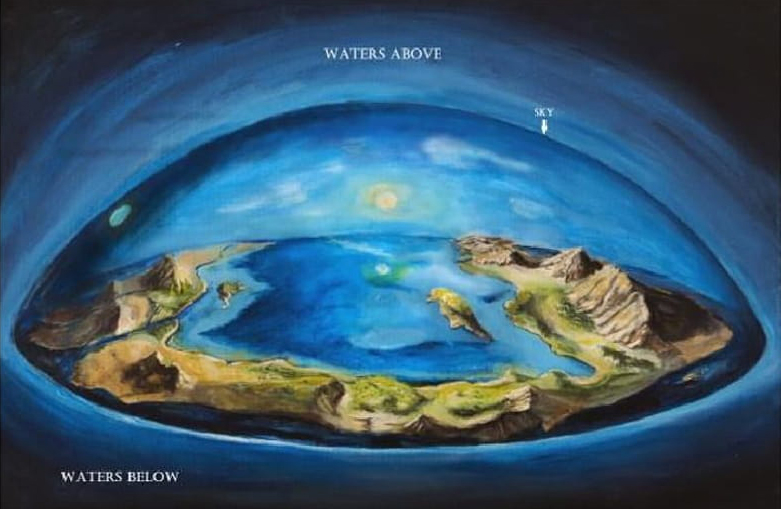
|
This is a non-WLC article. When using resources from outside authors, we only publish the content that is 100% in harmony with the Bible and WLC current biblical beliefs. So such articles can be treated as if coming directly from WLC. We have been greatly blessed by the ministry of many servants of Yahuwah. But we do not advise our members to explore other works by these authors. Such works, we have excluded from publications because they contain errors. Sadly, we have yet to find a ministry that is error-free. If you are shocked by some non-WLC published content [articles/episodes], keep in mind Proverbs 4:18. Our understanding of His truth is evolving, as more light is shed on our pathway. We cherish truth more than life, and seek it wherever it may be found. |

If you want to demonstrate that the Earth is a globe based on the Bible, you should reference a verse other than Isaiah 40:22, as this verse does not support that claim. If you intend to use this verse to prove a globe, there are at least three main issues with it: the circle, the grasshoppers, and the tent.
Is. 40:22 It is he that sitteth upon the CIRCLE of the Earth, and the inhabitants thereof are as grasshoppers; that stretcheth out the heavens as a curtain, and spreadeth them out as a TENT to dwell in
Frisbees and dinner plates are shaped like circles, which are indeed round. A circle is not the same as a globe, a ball, or a sphere, even if a ball can look like a circle if viewed in only one dimension.
The term “Circle” in the verse above translates from the Hebrew noun chug (Strong’s 2329), which means circle, vault, or horizon. (Note that it is not translated as ball or sphere.) Aside from this verse, it appears two more times in the Bible. In Job 22:14, we read about Yahuwah walking on the circle/vault of heaven (walking on the firmament of heaven), and in Proverbs 8:27, we find that this circle was inscribed on the face of the deep. The KJV phrases it “when he set a compass upon the face of the depth. " A ball lacks a side that could be considered “a face, " whereas a flat Earth does. The NKJV states, “When He drew a circle on the face of the deep. " It is challenging (or rather impossible) to draw a sphere or a globe onto something, but it is certainly possible to draw or inscribe a circle onto something.
Job 22:14 Thick clouds are a covering to him, that he seeth not; and he walketh in the circuit of heaven. (KJV)
Proverbs. 8:27 When He prepared the heavens, I was there, When He drew a circle on the face of the deep, (NKJV)
Note above that it would not make sense to draw “a globe” on the face of the deep. Compare also:
Job 26:10: “He has inscribed a circle (Strong’s 2328) on the surface of the waters At the boundary of light and darkness. (NASB)

The above noun (chug) is connected to the Hebrew verb with the same name, which is spelled chug (Strong’s 2328), which means to draw around and to make a circle. It is only found in Job 26:10, where we can read that Yahuwah has inscribed a circle on the surface, or (as in KJV) “compassed the waters.”
Isaiah 40:22 further suggests that the inhabitants look like grasshoppers when Yahuwah sits on this circle (the firmament). This requires a specific elevation, which works well with a physical firmament placed high over a round Earth. An elevation is also implied in Job 22:12, where we can read: “Surely Elohim is at the zenith of the heavens [shamayim] and looks down on all the stars, high as they are.” Note that it says that Yahuwah “looks down” on the stars when he sits or walks around on the firmament.
The morning star (Lucifer) wanted to exalt his throne above the stars of Yahuwah, and he is not talking about the top of the universe but above the heights of the clouds. This is where he imagined the throne of Yahuwah to be – above the clouds. The throne of Yahuwah is indeed described to be just above the firmament in the sky, and based on the creation account in Genesis, the stars were placed in the firmament.
Is. 14:12 How art thou fallen from heaven, O Lucifer, son of the morning! how art thou cut down to the ground, which didst weaken the nations!13 For thou hast said in thine heart, I will ascend into heaven, I will exalt my throne above the stars of El: I will sit also upon the mount of the congregation, in the sides of the north. 14 I will ascend above the heights of the clouds; I will be like the most High.
Ez. 1:26 And above the firmament that was over their heads was the likeness of a throne, as the appearance of a sapphire stone: and upon the likeness of the throne was the likeness as the appearance of a man above upon it.
Gen. 1:14 And Elohim said, Let there be lights in the firmament of the heaven to divide the day from the night; and let them be for signs, and for seasons, and for days, and years:15 And let them be for lights in the firmament of the heaven to give light upon the Earth: and it was so.16 And Elohim made two great lights; the greater light to rule the day, and the lesser light to rule the night: he made the stars also.17 And Elohim set them in the firmament of the heaven to give light upon the Earth,
The same verse (Is. 40:22) also uses the analogy of the heavens stretched out as a curtain and spread out as a TENT to dwell in – for the inhabitants who look like grasshoppers. It is almost impossible to imagine the picture of a tent placed on a globe where all the inhabitants live. It is a perfect analogy if we imagine a flat Earth with a firmament over it, and especially if we also imagine the Tabernacle during the Exodus.
While chug is not a translation for ball, there is, however, a word for “ball” that Isaiah could have used if this is what he wanted to express, but he did not use it in the above verse. He did, however, use it in Is. 22:18 where the ball is a translation from dur (Strong’s 1754):
Is. 22:18 18 He will surely violently turn and toss thee like a BALL into a large country: there shalt thou die, and there the chariots of thy glory shall be the shame of thy lord’s house.
Isaiah also describes Yahuwah as having the Earth as a footstool. It is hard to picture Yahuwah with a constantly moving and spinning ball under his feet, but the analogy works perfectly if we imagine the Earth to be flat, with a firmament and with four pillars, plus naturally standing still.
Isaiah 66:1 Thus saith the Lord, The heaven is my throne, and the Earth is my footstool: where is the house that ye build unto me? and where is the place of my rest?

In the Bible, the Earth is described as immovable, standing on pillars, with a firmament above it, positioned at the very center of Yahuwah’s creation, rather than as a moving object like a spinning ball rotating at 1,000 mph while speeding faster than a bullet around the sun at 67,000 mph. This is why people who believe the former should at least be respected rather than ridiculed. But does it not also say that the Earth hangs upon nothing? How does this fit either model?
Job 26:7 He stretcheth out the north over the empty place, and hangeth the Earth upon nothing.
Other translations use the word “void, " which might lead the reader to consider the creation account and the phrase, “the Earth was without form and void. " Perhaps Job’s description refers to the moment when Yahuwah has just created the Earth, suspending it on nothing, then proceeding to divide the waters and connect it to pillars. This verse does not resonate well if we envision a spinning ball rotating around the sun, as such a constantly moving sphere does not hang still on anything and does not require pillars.
Isaiah 13:13 Therefore I will shake the heavens, and the Earth shall remove out of her place, in the wrath of the Lord of hosts, and in the day of his fierce anger.
Ps. 104:5 5 Who laid the foundations of the Earth, that it should not be removed for ever.
The Bible refers to the four corners in several verses, both concerning the entire Earth and specific lands, such as Israel. The land of Israel is not shaped like a globe but can be envisioned as flat. The term " four corners " might be interpreted literally or as an analogy used by the writers to convey wholeness. For instance, in Acts 10:11 and 11:15, Peter sees a sheet knitted at the four corners, containing various beasts. Naturally, this sheet must have been quite flat, and everything within its four corners was acceptable for Peter to eat. Similarly, Israel is compared to four corners in Ezekiel 7:2, even though it is not square like sheets. Revelation 7:1 seems to refer to the four corners of the Earth as a physical reality, with four angels holding back four winds.
Acts 10: 11 And saw heaven opened, and a certain vessel descending upon him, as it had been a great sheet knit at the four corners, and let down to the Earth: + Acts 11:5
Ez. 7:2 Also, thou son of man, thus saith the Lord Yahuwah unto the land of Israel; An end, the end is come upon the four corners of the land.
Rev. 7:1 And after these things I saw four angels standing on the four corners of the Earth, holding the four winds of the Earth, that the wind should not blow on the Earth, nor on the sea, nor on any tree.
See also this verse about the four corners, and note the word “breadth” which is interesting:
Rev. 20:8 And shall go out to deceive the nations which are in the four quarters of the Earth, Gog, and Magog, to gather them together to battle: the number of whom is as the sand of the sea.9 And they went up on the BREADTH of the Earth, and compassed the camp of the saints about, and the beloved city: and fire came down from Yahuwah out of heaven, and devoured them.
The word “breadth” above describes the surface of the Earth, not parts of it. It is a translation from the noun πλάτος/platos (Strong’s 4114) and can be rendered as width or broad plain. The corresponding adjective is πλατύς/platus (Strong’s 4116), which can describe a street, as in Matt. 7:13 (flat and stretched out). The related verb is πλάσσω/plassó (Strong’s 4111), which translates as form or mold. The French word “plateau” signifies a level or nearly level portion of the Earth’s surface. This term derives from platel, which describes a flat object, like a plate. In Swedish, the word for “flat” is “platt,” similar in other Germanic languages.
The Bible includes parables and analogies, and even if they don't always describe real things or events, they signify something and are used for a purpose. The author aims for the reader to visualize a certain image while reading analogies, poetry, or parables. Consequently, we cannot disregard the analogies we dislike or only emphasize those we favor. According to the Bible, a sufficiently tall tree would be visible from the Earth’s farthest reaches. While it might be an exaggeration (or hyperbole), if the Earth is a globe, why would the devil even need to take Yahushua to a high place?
Dan. 4:11 The tree grew, and was strong, and the height thereof reached unto heaven, and the sight thereof to the end of all the Earth
Matt. 4:8 Again, the devil taketh him up into an exceeding high mountain, and sheweth him all the kingdoms of the world, and the glory of them.
This does not mean we have proven that the Earth is flat, but it certainly appears that the Bible suggests it does (with an honest reading), especially if we also consider the book of Enoch.
Interestingly, Wernher von Braun (the German aerospace engineer and space architect hired by NASA) had the following psalm inscribed on his gravestone, describing the psalmist's awe at Yahuwah’s creation of the firmament, which reveals Yahuwah’s handiwork:
Ps. 19:1 The heavens declare the glory of Yahuwah; and the firmament sheweth his handywork.

This is a non-WLC article by Annika Björk. The article is condensed from the following source: https://blogs.crossmap.com/stories/circle-of-the-earth-not-a-ball-globe-or-sphere-is-4022-ZzWXD_2UTtyy1yppF9pkg
We have taken out from the original article all pagan names and titles of the Father and Son, and have replaced them with the original given names. Furthermore, we have restored in the Scriptures quoted the names of the Father and Son, as they were originally written by the inspired authors of the Bible. -WLC Team